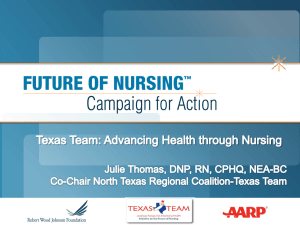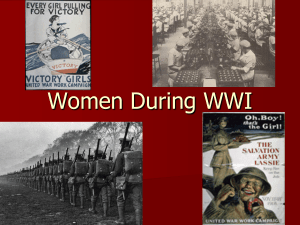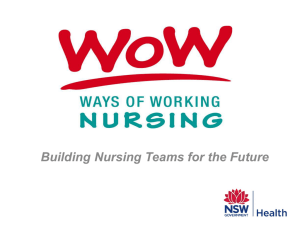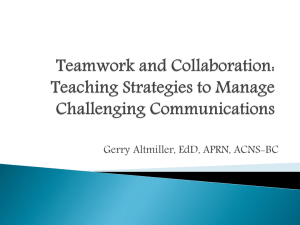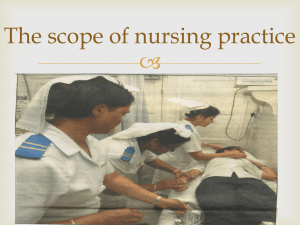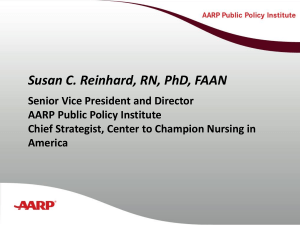Future of Nursing - Campaign for Action
advertisement
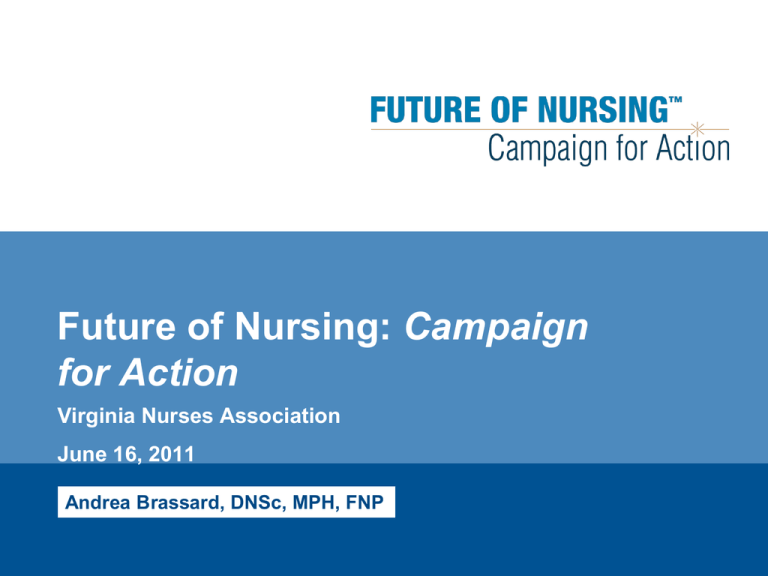
Future of Nursing: Campaign for Action Virginia Nurses Association June 16, 2011 Andrea Brassard, DNSc, MPH, FNP Health Care System Challenges Fragmentation High costs Primary care shortage Health care disparities Aging and sicker population RWJF’s Commitment to Improving Care • RWJF mission: to improve health and health care for all Americans • Need to address challenges facing nursing to address challenges facing our health system • Center to Champion Nursing in America at AARP IOM Report • High-quality, patientcentered health care for all will require a transformation of the health care delivery system Campaign Vision • All Americans have access to high-quality, patient-centered care in a health care system where nurses contribute as essential partners in achieving success Campaign for Action Education Practice Data Campaign for Action Leadership Collaboration Education Increase to 80 percent the proportion of nurses with BSN by 2020 Double number of nurses with doctorate by 2020 Implement nurse residency programs Promote lifelong learning Education • Evidence – Significant association between educational level and patient outcomes – 6 percent of AD grads get advanced degree, enabling them to teach and serve as PCPs, compared to 20 percent of BSN grads Practice • All practitioners should practice to full extent of their education and training • Optimal care – Physicians, nurses and other health professionals work in team-based model of care delivery – Models of care maximize time that providers can spend on their respective roles and responsibilities to patients Practice • Evidence: More than 10 studies show equivalent patient outcomes when care is provided by APRN or MD for certain services – Includes two Cochrane reviews – Randomized clinical trial published in JAMA – Office of Technology Assessment • No studies show care is better in states that do not allow APRNs to practice to full extent of education and training Practice Collaboration • Integrated, collaborative, patient-centered health care teams • Foster interprofessional education, training and practice Leadership • Nurses bring important viewpoint to management and policy discussions • Prepare more nurses to help lead improvements in health care quality, safety, access and value Leadership • Gallup survey of 1,500 opinion leaders* said nurses should have more: – Influence in reducing medical errors, increasing quality of care, promoting wellness – Input and impact in planning, policy development and management * RWJF, 2010 Nurse Leaders in the Boardroom • Survey of 1,000 U.S. hospitals* found: – Nurses account for only 6 percent of board members – Physicians are 20 percent of board members – Other clinicians are 5 percent of board members * American Hospital Association, 2011 Data • Improve health care workforce data collection to better assess and project workforce requirements – Research on health care workforce is fragmented – Need data on all health professions Diversity Increase workforce diversity • Nurses should reflect patient population in terms of gender, race and ethnicity • All nurses should provide culturally competent care Campaign Strategies Diverse Stakeholders Research, Monitoring, Evaluation Policy-makers RWJF AARP Advisory Committee Grantmaking Action Coalitions Communications Strategic Advisory Committee Members Judy Ann Bigby, MD, Massachusetts Secretary of HHS Sheila Burke, RN, (Chair), Harvard Kennedy School of Government Linda Burnes Bolton, RN, CNO, Cedars Sinai Medical Center Lloyd Dean, CEO, Catholic Healthcare West Christina Esperat, RN, Associate Dean, Texas Tech University Chip Kahn, President, Federation of American Hospitals Darrell Kirch, MD, CEO, American Association of Medical Colleges Alan Morgan, CEO, National Rural Health Association Debra Ness, President, National Partnership for Women and Families Bill Novelli, Professor, Georgetown University School of Business Jack Rowe, MD, Professor, Columbia University Antonia Villarruel, RN, Associate Dean, University of Michigan School of Nursing Phyllis Wise, PhD, Interim President, University of Washington Campaign for Action RWJF/AARP seeking support from: • • • • • • • • • health professions payers consumers business policy-makers philanthropies educators hospitals and health systems public health agencies Nursing must be considered societal issue! Examples Organization Commitment National Hispanic Medical Association Working with members on initiative to improve interdisciplinary education Consumers Advancing Patient Safety Challenged nursing members to identify and place a nurse on their board Convenient Care Association Working with national members who have community partners to increase Coalition involvement Leapfrog Group Encouraging hospitals to achieve magnet status Target Promised to engage its clinical nurses in leadership positions and opportunities Campaign for Action Action Coalitions • Long-term alliances • Field strategy to move key nursing issues forward at local, state and national levels • Expect to be in all states by end of 2012 • Capture best practices, networking To become part of a coalition, go to: www.thefutureofnursing.org Campaign for Action State Involvement WA ME MT ND OR MN VT ID NH SD WI NY WY MI IA NV PA NE IN UT OH IL CA CO WV KS AZ MO VA KY AR SC GA MS AL TX LA AK FL Map Legend Action Coalition State UPDATED: 6.6.2011 CT NJ DE MD DC NC TN OK NM HI MA State Involvement RI Campaign Resources • Visit us on the Web at: www.thefutureofnursing.org • Follow us on twitter at: www.twitter.com/futureofnursing • Join us on Facebook at: http://facebook.com/futureofnursing
